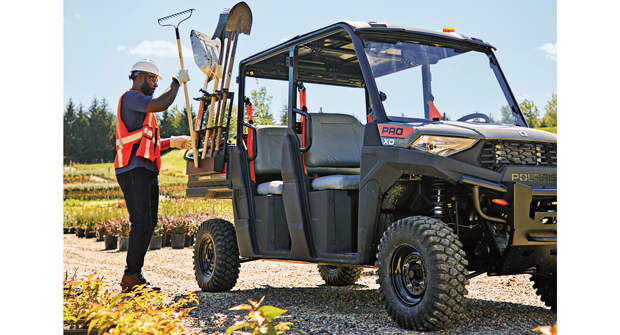
Contractors are quick to discuss the productivity and versatility a utility vehicle (UTV) brings to their operation. As for how exactly they use their UTVs, that answer varies.
Landscape Management talked with Kevin Stone, regional fleet manager at Landscape Concepts Management based in Illinois with locations throughout the Midwest; Brian Kamstra, owner of Superior Landscape Management in Byron Center, Mich.; and Shawn Locker, president of Blue River Nursery in Columbia City, Ind., about why and how their businesses utilize these tools.
Why they like UTVs
Landscape Concepts Management’s services include commercial landscape management, maintenance, construction, irrigation and tree services. Stone says it is cheaper to use utility vehicles instead of trucks on jobs like clearing grounds or cleaning sidewalks.
“They’re smaller, lighter and easier on the turf,” Stone says. “We do a lot of large corporate campuses, along with retirement communities. A utility vehicle would come to about $20,000 to $25,000 to use. Meanwhile, the truck will come to around $60,000.”
Additional design/build crews use utility vehicles to haul rocks or bricks and install filling behind a retaining wall, Stone says. Other departments also rely on UTVs to get the job done, all season long.
“We’ve used them for snow removal for sidewalks or salting sidewalks,” Stone says. “And in our turf department, we have hundred-gallon sprayers in the back because we do liquid applications for fertilizer. We can pick up garbage and control backyard use where we can’t fit a truck or a skid loader. The things can hit backyards and tough areas where one truck can’t go.”
Contractors can add many attachments to a utility vehicle, such as blades for spreading dirt or pushing snow, or winches to help pull tree stumps. An add-on toolbox keeps a crew’s tools locked up and secure.
“They can be used for transportation around large sites,” Stone says. “We do that with certain sites for irrigation jobs. With the workers who have to make sure things are working right, they will just hop on the vehicle and move around.”
Load it and go
Superior Landscape Management offers mowing, design/build, fertilizing, snow removal and salting. Kamstra estimates his company serves 60 percent residential and 40 percent commercial clients.
“This winter alone we will be using (UTVs) for snow plowing, including long stretches of sidewalks and smaller parking lots that we can’t fit our bigger trucks in and salting sidewalks,” Kamstra says. “In the springtime, we use it to mulch. And we’ve used it on some irrigation installs this year on bigger properties.”
Kamstra adds that his company uses UTVs for pruning at condominiums because their utility vehicles have a dump bed on them. Crews can load up the pruning clippings and easily dump them.
“You can load a utility vehicle with dirt or just about anything,” Kamstra says. “It’s less labor than what you will have to do with using tools, like a single wheelbarrow. We try to use them as much as we can. It is one of those things that you can buy for a specific aspect of your business before it becomes more of a daily piece of equipment, like a pickup truck.”
For Locker and the team at Blue River Nursery in Indiana, utility vehicles help with some of the walking and stress of performing daily tasks. He says without them, Blue River Nursery’s operations would be less efficient. His company serves around 90 percent residential and 10 percent commercial clients.
“We use it to access a greater part of the property, to plant and move plants around the nursery,” Locker says. “If you have larger properties to maintain, they can make you more efficient. You’re never going to get around the hard work in this business. However, you can make it a little bit easier.”

